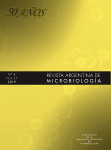Ver ítem
- xmlui.general.dspace_homeCentros e Institutos de InvestigaciónCIAP. Centro de Investigaciones AgropecuariasInstituto de Investigación Animal del Chaco SemiáridoArtículos científicosxmlui.ArtifactBrowser.ItemViewer.trail
- Inicio
- Centros e Institutos de Investigación
- CIAP. Centro de Investigaciones Agropecuarias
- Instituto de Investigación Animal del Chaco Semiárido
- Artículos científicos
- Ver ítem
Prevalencia sérica de Neospora caninum y factores de riesgo asociados a su transmisión en tambos de la provincia de Salta, Argentina
Resumen
El objetivo de este trabajo fue conocer la seroprevalencia de Neospora caninum en los bovinos de los tambos del Valle del Lerma (Salta, Argentina) y los factores de riesgo asociados a la transmisión de este parásito en esta región. Se tomaron muestras de suero de aproximadamente 40 vacas en cada tambo, que fueron analizadas por ELISA indirecto para detectar anticuerpos contra N. caninum. También se discriminó entre infecciones crónicas y agudas midiendo
[ver mas...]
El objetivo de este trabajo fue conocer la seroprevalencia de Neospora caninum en los bovinos de los tambos del Valle del Lerma (Salta, Argentina) y los factores de riesgo asociados a la transmisión de este parásito en esta región. Se tomaron muestras de suero de aproximadamente 40 vacas en cada tambo, que fueron analizadas por ELISA indirecto para detectar anticuerpos contra N. caninum. También se discriminó entre infecciones crónicas y agudas midiendo la avidez de dichos anticuerpos. Todos los tambos presentaron al menos un bovino seropositivo y la media fue de 35,3 ± 14,9% de animales positivos. También se detectaron anticuerpos específicos en caninos presentes en 9 de los 16 tambos, con un valor de seropositividad del 71,7 ± 19,9%. El 56,3% de los bovinos seropositivos cursaban infecciones agudas. Se halló una asociación negativa entre la seroprevalencia y el índice de avidez de los anticuerpos específicos, lo que indica que la presencia de animales con infecciones agudas se asocia a mayor seroprevalencia. Los campos con pastoreo presentaron mayor cantidad de infecciones recientes. Estos resultados revelan por primera vez la importancia de este parásito en los tambos de la región y la necesidad de propiciar el desarrollo de programas de control considerando los distintos factores de riesgo que afectan la situación epidemiológica de la enfermedad.
[Cerrar]
The objective of this work was to determine the seroprevalence of Neospora caninum in cattle in Valle de Lerma, province of Salta, Argentina, and the risk factors associated with the disease. Serum samples were taken from 40 cows in each dairy herd, which were analyzed by indirect ELISA to detect antibodies against N. caninum. Chronic and acute infections were discriminated by measuring the avidity of these antibodies. All the herds exhibited at least one
[ver mas...]
The objective of this work was to determine the seroprevalence of Neospora caninum in cattle in Valle de Lerma, province of Salta, Argentina, and the risk factors associated with the disease. Serum samples were taken from 40 cows in each dairy herd, which were analyzed by indirect ELISA to detect antibodies against N. caninum. Chronic and acute infections were discriminated by measuring the avidity of these antibodies. All the herds exhibited at least one seropositive animal, the mean being 35.3 ± 14.9% of positive animals. Specific antibodies were also detected in dogs present in 9 of the herds, which showed a seropositivity value of 71.7% ± 19.9%. Among the seropositive animals, 56.3% showed acute infections. A negative association was found between seroprevalence and the avidity index of specific antibodies, indicating that the presence of animals with acute infections is associated with higher seroprevalence. Fields with grazing showed more recent infections. These results show for the first time the importance of this parasite in this particular region and the need to promote the development of control programs considering the different risk factors that affect the epidemiological situation of the disease.
[Cerrar]

Fuente
Revista Argentina de Microbiología (2020)
Fecha
2020-09-11
Editorial
Elsevier
ISSN
0325-7541
Formato
pdf
Tipo de documento
artículo
Palabras Claves
Derechos de acceso
Abierto
 Excepto donde se diga explicitamente, este item se publica bajo la siguiente descripción: Creative Commons Attribution-NonCommercial-ShareAlike 2.5 Unported (CC BY-NC-SA 2.5)
Excepto donde se diga explicitamente, este item se publica bajo la siguiente descripción: Creative Commons Attribution-NonCommercial-ShareAlike 2.5 Unported (CC BY-NC-SA 2.5)


